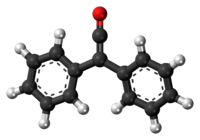Diphenylketene
 |
|
 |
|
| Names | |
|---|---|
|
IUPAC name
2,2-Di(phenyl)ethenone
|
|
| Other names
Diphenylethenone
|
|
| Identifiers | |
|
3D model (JSmol)
|
|
| ChemSpider | |
|
PubChem CID
|
|
|
|
|
|
| Properties | |
| C14H10O | |
| Molar mass | 194.23 g·mol−1 |
| Appearance | Red-orange oil |
| Melting point | 8 to 9 °C (46 to 48 °F; 281 to 282 K) |
| Boiling point | 118 to 120 at 1mmHg |
|
Except where otherwise noted, data are given for materials in their standard state (at 25 °C [77 °F], 100 kPa).
|
|
|
|
|
| Infobox references | |
Diphenylketene is a chemical substance of the ketene family. Diphenylketene, like most disubstituted ketenes, is a red-orange oil at room temperature and pressure. Due to the successive double bonds in the ketene structure R1R2C=C=O, diphenyl ketene is a heterocumule. The most important reaction of diphenyl ketene is the [2+2] cycloaddition at C-C, C-N, C-O, and C-S multiple bonds.
Diphenyl ketene was first isolated by Hermann Staudinger in 1905 and identified as the first example of the exceptionally reactive class of ketenes with the general formula R1R2C=C=O (R1=R2=phenyl group).
The first synthesis by H. Staudinger was based on 2-chlorodiphenylacetyl chloride (prepared from hydroxy(diphenyl)acetic acid and thionyl chloride) from which two chlorine atoms are cleaved with zinc in a dehalogenation reaction:
An early synthesis uses benzilmonohydrazone (from Diphenylethanedione and hydrazine hydrate), which is oxidized with mercury(II)oxide and calcium sulfate to form mono-diazoketone, and is then converted into the diphenylketene at 100 °C under nitrogen elimination in 58% yield:
A further early diphenylketene synthesis originates from Eduard Wedekind, who had already obtained diphenyl ketene in 1901 by the dehydrohalogenation of diphenylacetyl chloride with triethylamine, without isolation and characterization though. This variant was also described in 1911 by H. Staudinger.
...
Wikipedia
